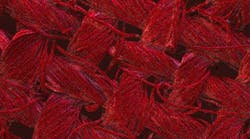A “hot-electron” textile could change the way people do laundry. Researchers at RMIT University, Melbourne, Australia, incorporated silver and copper nanoparticles into the textile’s composition, allowing it to release heat in the presence of visible light. As oscillating electrons at the surface of each nanoparticle gain kinetic energy, the generated heat can be used to degrade various organic materials, including stains and dirt, so that a person’s shirt can come clean as soon as they step out into the sun.
The scientists chose to use copper and silver nanoparticles (two species of noble metals) because their free electrons become excited by light on the visible spectrum. As resonance-frequency light hits the nanoparticles scattered within the textile, their free electrons begin to oscillate at higher intensities, releasing quantized packets of energy called plasmons. Like particles, these quasiparticles have momentum and position, and can transfer between carrier sites in a lattice.
2. Publications about plasmons and plasmonic devices have increased exponentially since the quasiparticles were discovered in the 1950s. âHot electronsâ on the surface of metals are widely investigated as energy-efficient heat sources to drive chemical reactions or induce current in the presence of visible light. (LSPR stands for local surface plasmon resonance. Courtesy of Google Scholar)
Noble-metal nanoparticles have already been extensively researched for light-activated self-cleaning textiles. However, RMIT’s fabric is specially designed so that its wettability, absorbency, and porosity allow for the transfer of plasmons from the electrons in the nanoparticles to the rest of the fabric.
The team grew the nanostructures by dipping the textile into various solutions. Their process is a form of electroless deposition, which simply means that none of its reactions required energy from an outside electrical source. Not only did this reduce the cost of deposition, but it took a mere 30 minutes—the shortest production time achieved in self-cleaning textile research.
The scientists are still researching textiles that will be effective for removing red wine and other more stubborn stains. Thus far, their product has been able to eliminate more neutral stains in a mere six minutes.
These advances could benefit more than those consumers who don’t want to wash their clothes. They could also lead to a range of 3D plasmonic devices that efficiently generate heat to drive chemical reactions within a substrate and produce electric currents in the presence of light.
"The advantage of textiles is they already have a 3D structure, so they are great at absorbing light,” says Dr Rajesh Ramanathan from Applied Sciences. In this case, the inherent 3D characteristics of fabric are beneficial for speeding up the process of degrading organic matter.”
The paper was published in Advanced Materials Interfaces.


